Mad Hedge Technology Letter
December 19, 2018
Fiat Lux
Featured Trade:
(HOW TECH IS EATING INTO HEALTHCARE COSTS)
(VEEV), (CRM), (GSK), (AZN), (MRK), (NVS), (DBX), (OKTA), (TWLO)

Mad Hedge Technology Letter
December 19, 2018
Fiat Lux
Featured Trade:
(HOW TECH IS EATING INTO HEALTHCARE COSTS)
(VEEV), (CRM), (GSK), (AZN), (MRK), (NVS), (DBX), (OKTA), (TWLO)

It’s undeniable that American healthcare costs are a big part of a family’s monthly expenses.
Rising deductibles and out-of-network fees are a few of the out-of-pocket costs that can singe a hole in the average joes’ pocket.
It was only in 2016 when healthcare insurance costs eclipsed more than $10,000 a year per person, and over the past 12 months, 68% of people surveyed admitted that future healthcare costs would probably consume a larger part of their earnings.
The result is that healthcare companies are making money hand over fist.
Is there something that I deduce from this lucrative part of the economy that has the potential to feed into the tech sector?
The tidal wave of money spilling into the healthcare industry has also given impetus to these firms hoping to buttress their networks and IT with modern tech infrastructure to take advantage of the efficiencies on offer.
Building the best cloud services geared towards specific industries has been a winning formula and the generated momentum will continue into the next calendar year.
Prime models can be seen all over the tech ecosphere and they will be big winners of 2019.
One example is Twilio (TWLO) who has quietly risen the bar for communication cloud products.
A panoply of small companies can now offer professionalized email, text message, automated voice mail services amongst other services that do the work of 100 employees.
Recently, I touched on a cloud company named Okta (OKTA) responsible for managing the facilitation of passwords.
This identity management company was formed by a group of former Salesforce executives.
In my book, a Salesforce (CRM) credential is a golden stamp of approval for newly formed cloud-companies seeking to develop new cloud products in broad industries.
Why?
Salesforce’s client relationship management platform (CRM) is ubiquitous and the most popular enterprise software.
The way they develop their model is by launching and acquiring new e-commerce and marketing services - which lure in customers into its walled gardens.
Salesforce also applies its artificial intelligence platform Einstein to harness customer relationships and help businesses carry out decisions based on data alone instead of testosterone and emotion.
This all means that Salesforce executives have their finger on the pulse of the cloud landscape and know how to build a cloud business from scratch which is valuable.
They know what certain industries require to mushroom and can deploy resources in the quickest way possible while surrounding themselves by hordes of software engineers who can be poached for a certain fee.
The framework being in place is a massive bounty for these executives who just line up the dots then motor on to an industry confirmed by the data.
And remember that 99.9% of people do not have access to this proprietary data.
Consequently, they know more about corporate America than most Fortune 500 CEOs.
Marrying up the healthcare industry to the cloud was just a matter of time.
Veeva Systems (VEEV) is a cloud-computing company focused on pharmaceutical and life sciences industry applications.
Founder and CEO of Veeva Systems Peter Gassner cut his teeth at Salesforce serving as Senior Vice President of Technology.
His job was building the salesforce.com platform including product, marketing and developer relations.
Gassner has effectively transplanted the Salesforce platform model and applied it to the life sciences industry and has done a great job doing it.
The Veeva Commercial Cloud includes a CRM platform that aids drug company’s management of clients.
The Veeva Vault is a tool that tracks industry regulations, clinical trials, and recommends actionable habits in the cloud.
Veeva's CRM platform is powered by the Salesforce1 app development platform and is integrated into the broader Salesforce Marketing and Service Clouds.
The first mover advantage has offered all the low-hanging fruit for Veeva.
The lack of competition surely never lasts but the extra time to pad their lead is only a positive to its business model.
Veeva has already lured in some of the health industries biggest names such as GlaxoSmithKline (GSK), AstraZeneca (AZN), Merck & Co. (MRK), and Novartis (NVS).
These heavy hitters are meaningfully tied to its ecosystem, and it is safe to say that these relationships are only scratching the surface and have the potential to expand as Veeva installs more add-on tools into its platform.
The popularity shows up in the numbers with Veeva’s 3-year sales growth rate hovering around 30%.
Even better, the profitability of Veeva is indicative of the strength in its business model. They are simply at the right place at the right time to capture the momentum from the digital crossover in the healthcare industry.
Many similar names like Dropbox (DBX) are enormous loss-making enterprises but Veeva has shrugged off this stereotype that many cloud companies of its size can’t be profitable.
The effect of being strategically placed in a position to cherry pick the lucrative healthcare industry has also seeped into the strong profit margins of Veeva able to grow it to over 32%.
Touching more on the profitability, EPS has kicked into gear sequentially rising 80%, and the long-term outperformance is backed up with a 3-year EPS growth rate of 41%.
This cloud company is incredibly profitable for its size, and part of that is the absence of competition which increases pricing power.
Dropbox does not have that luxury of favorable pricing schemes which cripple profitability and leads to attrition and just as harmful – a price war.
Veeva’s forecasts for next year blew past Wall Street’s estimates and the company is modeling for EPS of $1.58 and revenue around $856 million in 2019.
Gassner has even publicly acknowledged that he expects 2019 revenue to come in between $1 billion and $1.1 billion which is a full year ahead of schedule.
The bullish guidance is a clue that the overall cloud story is alive and kicking, and there is absolutely no weakness whatsoever.
Making this story even more compelling is that in the last five years, profits are up six-fold, revenue is up four-fold, and the number of new products is up three-fold.
As we advance into 2019, I believe Veeva is a buy-on-the-dip candidate because of its favorable market position, rapidly expanding margins, and its low enterprise value of $11 billion which deems it, as I daresay, a lucrative buyout target for larger industry cloud players like Salesforce.
The tech industry has a habit of coming full circle become of its network effect of capital, talent, and management.
I would be interested in dipping my toe into any of Salesforce’s offspring because these models are built to scale and are waiting on the doorstep to seize revenue from industry migrating to digital.
Okta did it, and Veeva Systems made the leap of faith too, confirming that the Salesforce method is a path to untold profits for cloud-based software companies.
When the market can finally digest the macro rigmaroles, shares for this innovative and hyper-growth cloud company is set to take off.
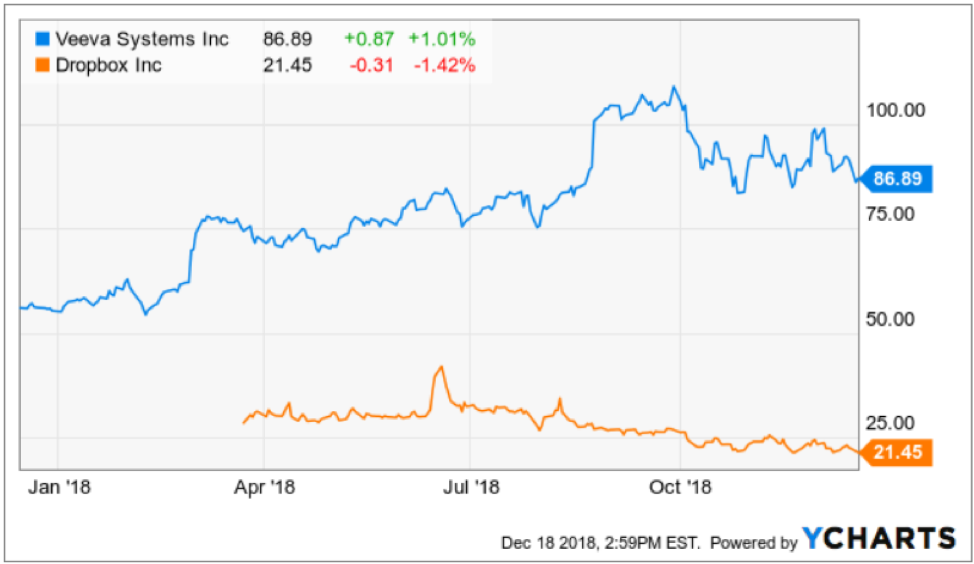
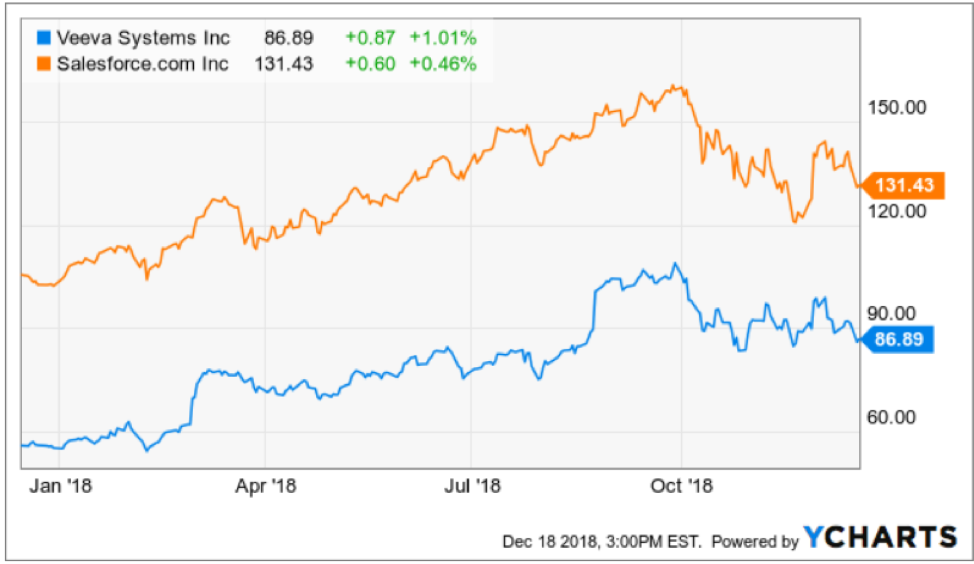
Global Market Comments
December 11, 2018
Fiat Lux
Featured Trade:
(JOHN THOMAS TV INTERVIEW Q&A)
(TLT), (FB), (USO), (GE), (PYPL), (SQ), (HD), (UUP), (FXE), (FXY)

Mad Hedge Technology Letter
December 10, 2018
Fiat Lux
Featured Trade:
(IT’S ALL ABOUT THE CLOUD)
(OKTA), (ZS), (DOCU), (INTU)

This is no Potemkin village!
That was my reaction when I examined the earnings reports from second-tier cloud companies Okta (OKTA), Zscaler (ZS), and DocuSign (DOCU).
Cloud companies aren’t going away anytime soon, please singe that into your memory.
Even during a winter Nasdaq (QQQ) swoon, software companies are delivering great earnings.
Ironically enough, the three aforementioned security-based cloud companies come at a time when global tech security is the laser-like focus of contentious geopolitics.
There isn’t a hotter topic circulating the gossip networks these days.
Okta is the best in show for identity management – a snazzy term for managing employees’ passwords.
Okta’s products are built on top of the Amazon Web Services cloud.
Coincidentally, Okta was erected in 2009 by a team of former Salesforce (CRM) executives. Salesforce is one of my favorite cloud-based software companies, offering a blueprint for success to other up-and-coming software companies.
Current Okta CEO and founder Todd McKinnon previously served as the Senior Vice President of Engineering at Salesforce.
Other founders include Okta COO Freddy Kerrest who also walked the corridors of Salesforce.
I can tell you that you could do much worse than starting a new software company with a collection of Salesforce upper echelon talent.
This all-star team is behind the insatiable growth of Okta whose revenue has grown over 600% since establishing itself.
Somewhere along the way at Salesforce, this veteran team became acutely aware of a lack of password security and the dire need for it.
This gang of brothers took it upon themselves to spin out of their former lives and develop this specialized cloud product.
Comparing with Intuit (INTU), the finance and accounting software company, readers can lucidly comprehend the superior growth trajectory of Okta.
I am not tarring Intuit as a bad tech company, it rather does justice to the growth model at Okta.
Okta was forecasted to grow between 43%-45% YOY in the previous quarter and shredded any remnant of doubt by posting 58% YOY of revenue growth.
Last quarter was also Okta’s first profitable quarter as a public company.
Customer expansion was another bright highlight with Okta adding 42% YOY.
Specific relationships that drove the bottom line was America’s second-largest traditional supermarket chain and parent of Safeway, Albertsons, Okta became responsible for their passwords on Albertsons’ e-commerce and loyalty programs.
Other relationships that gained traction were other blockbuster names such as the Transportation Security Administration, Sonoco, LendingClub, and Hertz.
The record third quarter also saw gross margin expansion from 68.4% to 71.9%.
CEO of Okta Todd McKinnon briefly summed up the firm’s outlook by gushing that Okta is “well positioned to further benefit from tailwinds as organizations continue their move to the cloud while digitally transforming and securing their businesses.”
McKinnon stole the words right out of my mouth.
Cloud-based software companies will be outsized winners in 2019 as investors start nitpicking more of which tech to own and which tech to dispose of.
This year spawned a massive divergence between tech who has legs and tech who will be dragged down to the depths of the ocean floor by the heavy weight of regulation, overwhelming competition, or just flat out poor management or inferior product development.
In mid-2018, the FANG shared up moves in unison, Facebook zigged and so did Amazon and friends, then they gleefully zagged together.
That trade unceremoniously fell apart swiftly when macro headwinds applied extreme pressure to each unique model.
Suddenly, the FANGs weren’t best pals anymore and the weaknesses became painfully exposed glaringly to the outside world.
Look for the FANG stocks to experience additional divergence as we moved forward because the low-hanging fruit has been picked and only the strong will excel 2019.
Before the recent turbulence, big tech stocks were assumed as one trade and that is done and dusted.
An exciting new chapter to the tech world and the fierce competition it breeds await with the much-praised unicorns of Uber, Lyft, Airbnb, and Slack going public next year.
As for Okta, analysts expected the company to guide to around a 45% YOY growth rate next year, but management took the liberty to forecast a more audacious revenue growth rate of 53% YOY to a tad below $400 million.
Okta’s management has gone out on a limb predicting revenue to surpass $500 million and maintain an annual growth rate of over 30% for the next five years.
Future revenue has a one-way ticket to $1 billion – quite impressive when you consider 2015 revenue came in at $41 million.
Another growth stock performing amid a tempestuous broader market is digital signature cloud company DocuSign.
The company expansion withstood any supposed softness to its business model outperforming expectations.
DocuSign improved on their 2nd quarter growth rate of 33% and sequentially accelerated to 37% last quarter.
Management jacked up revenue expectations to just under $700 million next year, almost three times the annual revenue of 2015.
The disappointing price action neglecting DocuSign’s bright performances is a sign of the current times.
Catching a horrid downdraft from its 2018 peak of $65 is a swift kick in the groin, but it sadly epitomizes the broader malaise whipsawing market volatility like a bull at a rodeo.
The price action is rare for a company displaying accelerating revenue growth with exciting revenue prospects.
Zscaler echoed the same positive sentiment recording a quarter to remember nudging up sales by a robust 59% easily beating forecasts.
Management geared towards premium-priced bundles spiking gross margin massaging the bottom line.
Next year’s annual guidance was nothing short of spectacular with management believing the company will crack $270 million of total revenue compared to analysts conservatively modeling $259 million in 2019.
Zscaler is still labeled a minnow in the larger landscape of the cyber security market and is the smallest of the three firms written about today, but that is gradually moving up the totem pole as the firm’s hyper-growth model is kicking into gear.
Gartner research estimates that the global information security market will eclipse $124 billion in 2019 offering many players an enlarging piece of the pie.
It is justifiable to bake in that Zscaler's prospects will outrun any broader weakness that tries to crimp the stock’s unfettered momentum.
With a current market capitalization slightly north of $5 billion, the growth potential may justify a premium valuation.
Investors fervently applauded the quarterly results elevating the stock 12% on the positive news.
Zscaler is now convinced it can spearhead consistent profitability and positive cash flow by 2020.
It’s hard not to see them decimate their own in-house projections.
These three shining stars of the cloud revolution are not papering over cracks of a dying model, they are front and center of a cohort leading the digital economy and the underlying outperformance backs up this premise.
Unfortunately, even if a company goes gangbusters, they could still be vulnerable to outside forces which are lamentably unavoidable.
A report published by S&P Global shows the tech industry growing earnings by 12% in 2019, only trailing health care and energy.
This is a great sign of things to come next year.
The demand for quality cloud products of this ilk is one theme that will perpetuate.
The American economy is on the verge of a whole slew of analog companies from other sectors traversing single file into the sweet spot of the data-dependent tech taxonomy clamoring for hybrid specialized offerings.
It is safe to say burgeoning cloud-based software companies with annual revenue of less than half a billion dollars are not only primed to take advantage of the digital migration phenomenon irrespective of the machinations in Washington or the fluctuations of treasury yields, but will post attractive financials numbers because of the law of large numbers that makes small companies’ results look better than they are on a percentage basis.
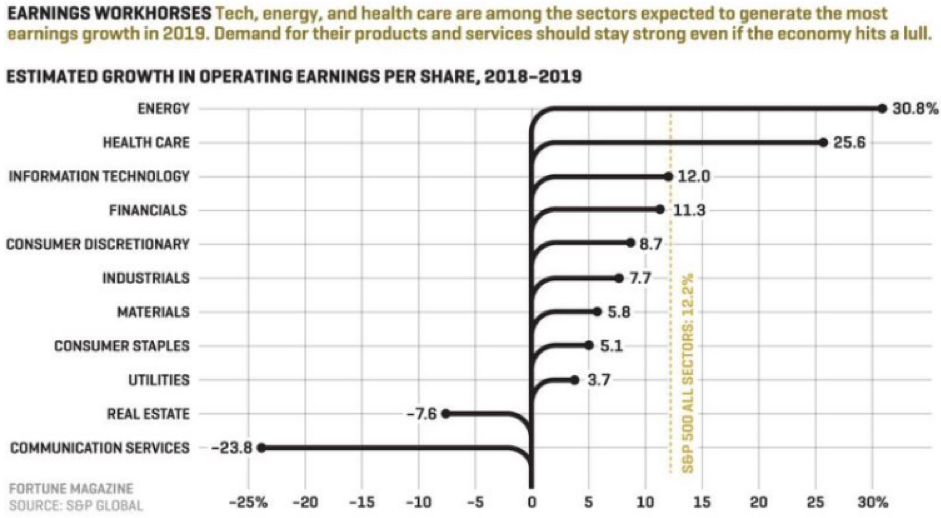
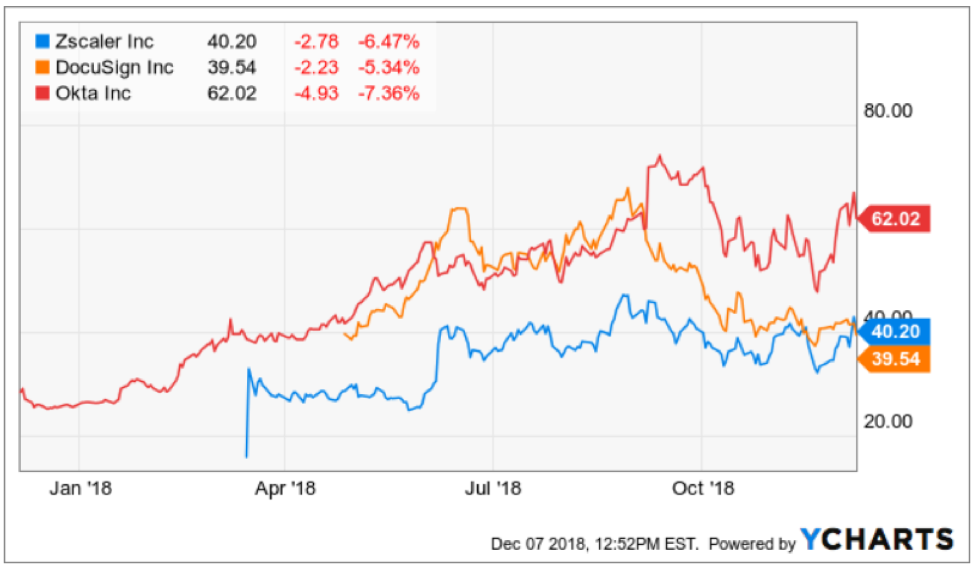
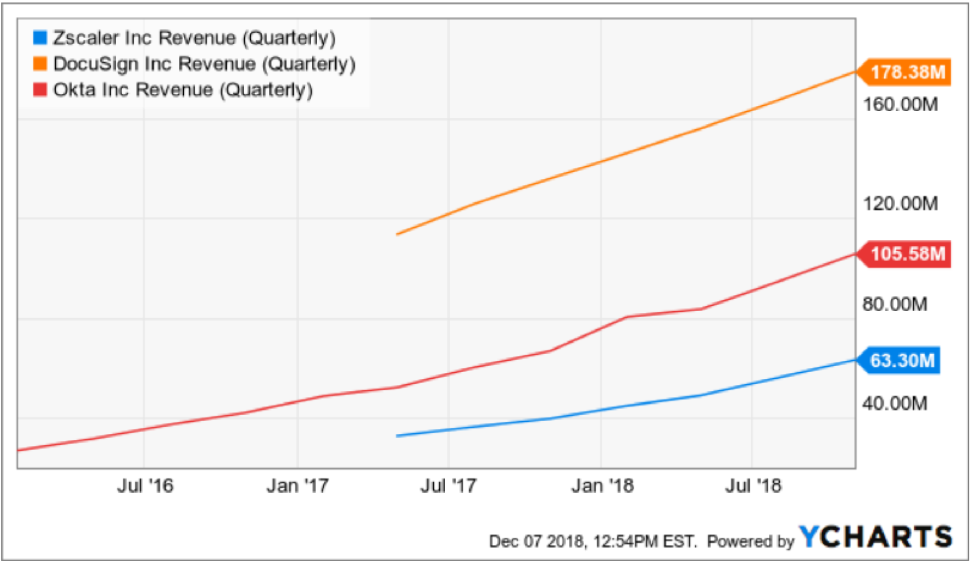
Legal Disclaimer
There is a very high degree of risk involved in trading. Past results are not indicative of future returns. MadHedgeFundTrader.com and all individuals affiliated with this site assume no responsibilities for your trading and investment results. The indicators, strategies, columns, articles and all other features are for educational purposes only and should not be construed as investment advice. Information for futures trading observations are obtained from sources believed to be reliable, but we do not warrant its completeness or accuracy, or warrant any results from the use of the information. Your use of the trading observations is entirely at your own risk and it is your sole responsibility to evaluate the accuracy, completeness and usefulness of the information. You must assess the risk of any trade with your broker and make your own independent decisions regarding any securities mentioned herein. Affiliates of MadHedgeFundTrader.com may have a position or effect transactions in the securities described herein (or options thereon) and/or otherwise employ trading strategies that may be consistent or inconsistent with the provided strategies.
This site uses cookies. By continuing to browse the site, you are agreeing to our use of cookies.
OKLearn moreWe may request cookies to be set on your device. We use cookies to let us know when you visit our websites, how you interact with us, to enrich your user experience, and to customize your relationship with our website.
Click on the different category headings to find out more. You can also change some of your preferences. Note that blocking some types of cookies may impact your experience on our websites and the services we are able to offer.
These cookies are strictly necessary to provide you with services available through our website and to use some of its features.
Because these cookies are strictly necessary to deliver the website, refuseing them will have impact how our site functions. You always can block or delete cookies by changing your browser settings and force blocking all cookies on this website. But this will always prompt you to accept/refuse cookies when revisiting our site.
We fully respect if you want to refuse cookies but to avoid asking you again and again kindly allow us to store a cookie for that. You are free to opt out any time or opt in for other cookies to get a better experience. If you refuse cookies we will remove all set cookies in our domain.
We provide you with a list of stored cookies on your computer in our domain so you can check what we stored. Due to security reasons we are not able to show or modify cookies from other domains. You can check these in your browser security settings.
These cookies collect information that is used either in aggregate form to help us understand how our website is being used or how effective our marketing campaigns are, or to help us customize our website and application for you in order to enhance your experience.
If you do not want that we track your visist to our site you can disable tracking in your browser here:
We also use different external services like Google Webfonts, Google Maps, and external Video providers. Since these providers may collect personal data like your IP address we allow you to block them here. Please be aware that this might heavily reduce the functionality and appearance of our site. Changes will take effect once you reload the page.
Google Webfont Settings:
Google Map Settings:
Vimeo and Youtube video embeds:
